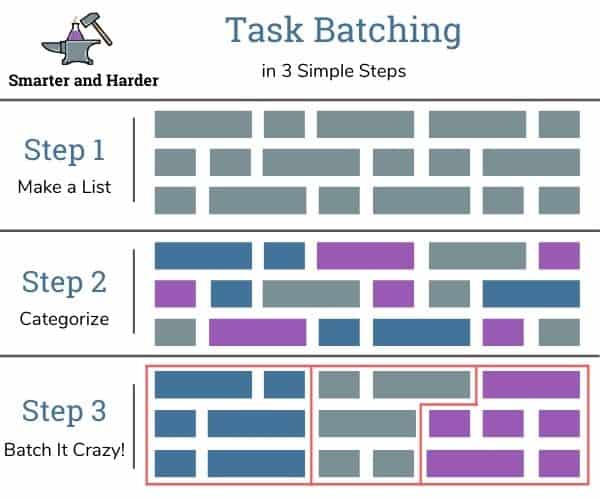When you have too many things to do and nowhere near enough time or mental resources to stay on top of it all, there’s no better way to self-manage than through a technique called task batching.
As an ambitious professional, task batching has saved my sanity. One of my favorite things about being a blogger is how many different parts of the job there are. I get to be a writer, web developer, graphic designer, marketer, and administrator. But without some way to compartmentalize all this, I’d be overwhelmed and running all over the place.
Here is where task batching comes in. By separating my work into meaningful areas and dedicating time to each group of tasks, I keep myself moving and on top of all these different work streams simultaneously.
The best part is that anyone can do this! Here’s how.
What is Task Batching?
Consider a scenario. You wake up, look at the day ahead, and immediately feel a stress headache coming on; you’re not sure how you’ll fit it all in. Maybe it’s a long workday with converging deadlines plus a list of things to do after leaving the office. Or, perhaps it’s a “day off” where you have 15 things you need to do, 15 more that you should get done soon, and a handful of things that would be great to fit in if you ever had the time.
We all have days like this at least once in a while, if not regularly. But, unfortunately, they’re usually stressful and exhausting. And the list of things on your plate can feel never-ending.
Task batching is a technique for managing busy, jam-packed days like these. The basic strategy looks something like this:
- List out the tasks you need to (or might like to) tackle.
- Look for patterns and sort the tasks into categories (e.g., these items involve phone calls/emails, or these are all creative).
- Organize your day by taking on these tasks one “batch” at a time, ideally from most important/urgent to least.
Grouping similar tasks together saves you time and energy and generally results in higher-quality work. Let’s take a closer look at how task batching overcomes the problem of multitasking and how you can start with a 3-step task batching strategy.
Productivity Benefits of Batching Your Time
In a recent post about single-tasking, I discussed how multitasking is a myth. The short story is that our brains aren’t great at doing many things simultaneously. Frequent context switching (moving between unrelated tasks) makes you less productive, more wiped out, and farther behind.
Like single-tasking, task batching is a way to alleviate this common problem (and actually, the two pair very nicely together!). In addition, this technique helps us work in a way that feels natural to our brains rather than pushing against the grain to force a particular result.
In his fantastic book Deep Work: Rules for Success in a Distracted World, Cal Newport explains how creating a disciplined environment of focus leads you to:
- Get more of your work done more quickly
- Produce a higher quality of work with fewer mistakes
- Save more of your mental and emotional energy
And task batching does all of these. Spending a reasonable period in one headspace builds focus. And with a high level of focus, we become much more effective — not to mention efficient — in that headspace.
In other words, batching work with similar work helps you build focus. With focus, you can achieve better quality work with less effort. And doing better work with less effort is what we’re all about around here.
Batching Work the Easy Way
As discussed above, task batching works in three simple steps:
- List out the work
- Find the patterns
- Organize the batches

1. List Out the Work
You probably don’t need much guidance on this one. You know what tasks you have to do and which ones you’d like to do. Depending on your unique situation and the types of work involved, it may make sense to look at this as a single-day-at-a-time exercise or to zoom out and plan your week. Feel free to mess around and see what makes the best fit.
It’s essential to write down the individual tasks in some way to reference them in the last two steps.
And one thing I’ll say here is that you don’t need to treat this as a strict must-do list. For a list of everything on your plate right now, it’s better to start by casting a wide net. Then, we can pare it down later.
2. Categorize Your List
Once you have your list, it’s time to start forming the batches. Go through the list, look for patterns, and begin putting tasks into categories.
When looking for patterns, some separations may be more helpful than others. The most important thing is to focus on the headspace each task requires of you over any other similarities. Consider the following four tasks:
- Respond to work emails
- Buy groceries
- Pay bills online
- Ship packages to clients
If you notice that #1 and #4 are job-related, while #2 and #3 are more focused on the household, you may consider breaking these into a “housework” batch and a “work-work” batch. But does it make sense to sit down at your desk to do emails, then go to the post office, then come home and sit at your desk to do bills, and then go back out for groceries?
In this case, a more effective way to batch would be office work (#1 and #3) and errands (#2 and #4). This setup would make for only one block of time sitting at the desk, and one out of the house, cutting down heavily on the time and effort to keep switching back and forth.
The main goal is to reduce the mental cost of frequently switching gears, so try to group activities that use similar gears. This is just one small example, but over a full day, batching your time can make a world of difference.
3. Batch It Up!
You probably get the gist of where this goes next. Now that you have all the tasks and know which batches they fit into, you can divide your time between them. Instead of moving from one job to whatever comes next, define your time by which group of things you’ll focus on.
It’s essential to think about your energy and what kind of day you’re setting up for yourself. Planning your energy trajectory, if you will. If one or more of your batches is heavily creative, stressful, or requires a lot of brain work, it may be best to put those early. Give yourself some big wins at the beginning, and then move on to more manageable batches afterward.
As you improve at planning and working in batches, you’ll start to notice you’re able to fit more tasks into the day and feel less behind on everything. There’s a good chance you’ll be able to fit in more of the things off your list from step 1 than you thought. But it’s okay if they don’t all fit in, especially at first. Just keep working at it, and you’ll be a task-batching pro in no time!
What Are You Going to Batch?
Task batching is a simple technique that pays you back in spades. It can turn a scattered and overwhelming day into a finely-tuned, smoothly running machine. What are you waiting for? Give it a try!
Do you know what some of your batches are going to look like? Have something you’re not sure how to batch? Let us know in the comments below!


This was so helpful Sam! Great ways to organize and make our day more productive! I agree with categorizing, I find that helps too!
Thanks Diana, I love finding ways to sort, organize, and categorize things!